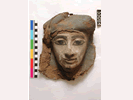| Homepage | Timeline | Maps | A-Z index | Learning |
Mummies and Mummification: Middle Kingdom
The treatment of the body was not very different from the Old Kingdom, although some advances seem to have been made. The body was wrapped in linen; the head was often (at least in elite burials) covered with a mummy mask. The viscera were sometimes removed and placed into canopic chests or jars. There are also burials with canopic jars, but with the viscera still inside the body: here it seems that a social class copied here a custom from a higher social level without having the resources to enact it in full.
The face of the mayor Djehutynakht buried at Der el-Bersheh was - as attested already for the Old Kingdom - modelled in linen. A new feature in the Middle Kingdom is the use of resin. The surface of the skin was coated with it. The well preserved bodies of some royal women found at Deir el-Bahari (Eleventh Dynasty) show that the viscera were dissolved and partially extracted through the rectum or/and vagina. The body of the 'overseer of the storerooms' Wah had the liver, stomach and intestines removed, while the heart was still at its place. The body of the lady Senebtisi (late Twelfth Dynasty) was covered with a layer of pitch.
|
mummy masks
|
canopic jars
|
Ikram/Dodson 1998: 114-116 (summary)
Mummification in:
Old Kingdom | Middle Kingdom | New Kingdom | Third Intermediate Period | Late Period to Coptic Period
